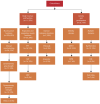Physical function measures in ICU survivors, where to now? A scoping review
- PMID: 39726835
- PMCID: PMC11669153
- DOI: 10.7196/SAJCC.2024.v40i2.1742
Physical function measures in ICU survivors, where to now? A scoping review
Abstract
Background: Growing evidence is describing the long-term morbidity experienced by critical illness survivors, a major contributing factor being impaired physical function. Consensus is yet to be reached on which physical function measures should be included in this population. This review aimed to describe physical functioning measurement instruments used in longitudinal studies of critical illness survivors, based on the International Classification of Function (ICF).
Methods: An electronic database search of EbscoHost, Web of Science and Scopus was conducted from inception to November 2023. Two reviewers independently applied the inclusion and exclusion criteria to titles, abstracts and full text-studies. Extracted data included year of publication; country; participant age; follow-up timeframes and physical measurement instruments used. Instruments were classified according to ICF domains.
Results: Eighty studies published between 1995 and November 2023 were included. Forty-four different outcome measures were identified. Most studies (68) included multiple followed-up points and were completed within a year, and few studies (12) follow-up beyond a year. Based on the ICF, 11 (25%) instruments measured impairments and 33 (75%) activity limitations. Muscle power functions were the most frequently measured impairment (65%), utilising manual muscle testing (37.3%). The six-minute walk test (6MWT) was the most frequently used instrument in the activity/participation domain (31.6%). Only one instrument addressed all five the physical activity/participation domains, while the majority focused on mobility domain.
Conclusion: Multiple tools are used to report on physical deficits experienced by ICU survivors, either measuring impairments or activity/ participation limitations. Most studies report on physical function within the first year of survival. The heterogeneity and inconsistency over time of instruments used prevents synthesis of data to determine intervention efficacy. The validity, predictive value and sensitivity of the reported measures within ICU survivors needs to be established, only then can intervention studies be designed to measure effectiveness.
Contribution of the study: This scoping review contributes to the existing literature and development of standardised core outcome measure sets (COMS) for critical illness research by providing a comprehensive and systematic mapping of physical function measurement instruments utilised in longitudinal studies of critical illness survivors. By categorising these instruments according to the International Classification of Functioning, Disability and Health (ICF) framework, the review offers a novel perspective on the current state of outcome measurement in this field.
Keywords: Critical care; critical illness; outcome assessment; post-intensive care syndrome; rehabilitation.
Copyright © 2024, Author(s).
Figures


Similar articles
-
Physical Impairments Associated With Post-Intensive Care Syndrome: Systematic Review Based on the World Health Organization's International Classification of Functioning, Disability and Health Framework.Phys Ther. 2018 Aug 1;98(8):631-645. doi: 10.1093/ptj/pzy059. Phys Ther. 2018. PMID: 29961847
-
International Classification of Functioning, Disability, and Health Domains of 60 Physical Functioning Measurement Instruments Used During the Adult Intensive Care Unit Stay: A Scoping Review.Phys Ther. 2019 May 1;99(5):627-640. doi: 10.1093/ptj/pzy158. Phys Ther. 2019. PMID: 30590839 Free PMC article.
-
Beyond the black stump: rapid reviews of health research issues affecting regional, rural and remote Australia.Med J Aust. 2020 Dec;213 Suppl 11:S3-S32.e1. doi: 10.5694/mja2.50881. Med J Aust. 2020. PMID: 33314144
-
Outcome Measurement in ICU Survivorship Research From 1970 to 2013: A Scoping Review of 425 Publications.Crit Care Med. 2016 Jul;44(7):1267-77. doi: 10.1097/CCM.0000000000001651. Crit Care Med. 2016. PMID: 26992067 Free PMC article.
-
Comparative content review of children's participation measures using the International Classification of Functioning, Disability and Health-Children and Youth.Arch Phys Med Rehabil. 2014 Jan;95(1):141-52. doi: 10.1016/j.apmr.2013.06.027. Epub 2013 Jul 12. Arch Phys Med Rehabil. 2014. PMID: 23851418 Review.
Cited by
-
Exploring Peripheral and Respiratory Muscle Weakness and Functional Impairments in ICU Patients: Insights From a Resource-Constrained Setting.Crit Care Explor. 2025 Mar 26;7(4):e1245. doi: 10.1097/CCE.0000000000001245. eCollection 2025 Apr 1. Crit Care Explor. 2025. PMID: 40138534 Free PMC article.
References
Publication types
LinkOut - more resources
Full Text Sources
Research Materials
